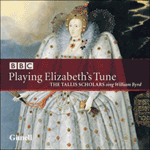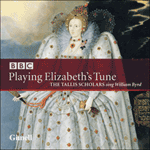With Mary’s death in 1558 the Latin rite was officially defunct in England. Nonetheless, the young Elizabeth (herself a skilled musician) maintained Catholic sentiments and encouraged the continued composition of Latin-texted music, even though such works could never be officially sung in the church. In 1575 Elizabeth granted Thomas Tallis and William Byrd full privilege and licence for twenty-one years ‘to imprint any and so many as they will of set songe or songes in partes, either in English, Latine,... or other tongues that may serue for musicke either in Churche or chamber’. The collection, containing seventeen pieces by each composer, was reputedly presented to the Queen on Accession Day in 1575 on 17 November in the seventeenth year of her reign. Byrd’s contribution included the monumental
Tribue, Domine, the longest of his early works, which is printed in three sections successively in the
Cantiones. Here Byrd expertly sustains variety and contrast throughout by employing homophony, antiphonal writing and two-, three-, five- and six-part polyphony, while paying close attention to the meaning and expression of the text, as he invariably did in his later Latin works.
from notes by David Skinner © 1998
Avec la mort de Marie en 1558, disparut officiellement le rite latin en Angleterre. Toutefois, la jeune Elisabeth (elle-même musicienne confirmée) entretint des sentiments catholiques et encouragea la mise en musique de textes latins, bien que de telles oeuvres n’aient jamais pu être chantées de manière officielle lors d’un office. En 1575, Elisabeth accorda à Thomas Tallis et à William Byrd le privilège et la licence absolus pour une période de vingt et un ans ‘d’imprimer autant qu’il leur plairait de chants ou chants en parties séparées mis en musique, que ce soit en anglais, latin,... ou toutes autres langues convenant à la musique d’église ou de chambre’. La collection, qui comportait dix-sept oeuvres de chaque compositeur, est censée avoir été présentée à la reine le jour de son avènement, le 17 novembre 1575, dans la dix-septième année de son règne. La contribution de Byrd incluait le monumental
Tribue, Domine, son oeuvre la plus longue, qui est imprimée en trois sections successives dans les
Cantiones. Byrd maintient de façon experte la variété et le contraste tout au long de l’oeuvre grâce à l’homophonie, l’écriture en alternance et la polyphonie à deux, trois, cinq et six voix, tout en prêtant la plus grande attention au sens et à l’expression du texte, ainsi qu’il le fit constamment dans ses oeuvres latines ultérieures.
extrait des notes rédigées par David Skinner © 1998
Français: Myrna Brasey
Mit dem Tod Marys im Jahre 1558 erlosch auch die lateinische Liturgie in England. Dennoch ließ die junge Elizabeth (selbst eine gewandte Musikerin) auch die katholische Gesinnung gelten und befürwortete die Komposition lateinisch textierter Musik, selbst wenn diese niemals offiziell in Kirchen gesungen werden durfte. So gestand sie 1575 Thomas Tallis und William Byrd für 21 Jahre das Monopol und die Lizenz zu, ‘jedwede vertonte Dichtung oder Dichtungen gleich in welcher Zahl in Stimmen zu drucken, sowohl in Englisch, Latein,… als auch in jeder anderen Sprache, die der Musik dienlich sein mag, sowohl in der Kirche, als auch in der Kammer.’ Die erste Sammlung,
Cantiones Sacrae, mit jeweils 17 Kompositionen beider Komponisten wurde der Regentin angeblich zum Jahrestag ihrer Thronbesteigung am 17. November 1575, im 17. Jahr ihrer Herrschaft überreicht. Unter den Beiträgen Byrds findet sich auch das monumentale
Tribue, Domine, das längste seiner frühen Werke, das in drei Abschnitten hintereinander in den
Cantiones gedruckt erscheint. Abwechslung und Kontrast erzielt Byrd hier meisterhaft dadurch, daß er sowohl homophone, als auch antiphonale Techniken sowie zwei-, drei-, fünf- und sechsstimmige polyphone Techniken anwendet, während er zugleich mit größter Aufmerksamkeit auf Sinn und Ausdruck des Textes achtet, was ausnahmslos auch für seine späteren Werken auf lateinische Texte gilt.
aus dem Begleittext von David Skinner © 1998
Deutsch: Matthias Lehmann
Colla morte di Maria, avvenuta nel 1558, il rito romano in Inghilterra ufficialmente scompare. Nondimeno, la giovine Elisabetta (musicista esperta ella stessa) conserva sentimenti cattolici ed incoraggia a continuare la composizione di musiche su testo latino, anche se tali lavori ufficialmente non possono esser mai cantati in chiesa. Nel 1575 la regina accorda a Thomas Tallis e ad William Byrd licenza e privilegio pieni per 21 anni ‘per stampare quali e quanti canti intonati od in partes essi vorranno, sia in inglese, latino [...] od in altre lingue che possano servire per la musica sia da chiesa che da camera.’ Una raccolta, contenente 17 lavori di ciaschedun compositore, vien presentata, a quel che si suppone, alla regina in quella stessa data (1575), anniversario della sua ascesa al trono, il 17 di novembre; quell’anno era anche il suo 17° di regno. Il contributo di Byrd includeva il monumentale
Tribue, Domine, il più lungo dei suoi primi lavori, stampato successivamente nelle
Cantiones diviso in 3 sezioni. Qui Byrd mantiene con perizia in ogni parte varietà e contrasti, impiegando omoritmia, scrittura antifonica e polifonia a 2, 3, 5 e 6 vv., e prestando nel contempo un’attenzione accurata al senso ed all’espressione del testo, come invariabilmente farà nelle composizioni latine più tarde.
David Skinner © 1998
Italiano: Bruno Meini


 Byrd: Playing Elizabeth's Tune
Byrd: Playing Elizabeth's Tune Byrd: Playing Elizabeth's Tune
Byrd: Playing Elizabeth's Tune
